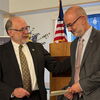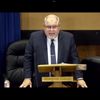Drummond Woodsum lawyers help Appalachian Mountain Club cash in on uncut trees
In his legal work for the Appalachian Mountain Club and the Maine Appalachian Land Trust, David Kallin has “walked the walk” and then some. This summer he hiked the entire 2,185-mile Appalachian Trail with his wife, their two children and the family dog.
It's not every law firm that would embrace the idea of one of its practice leaders taking off for six months to go for a long walk, but Drummond Woodsum gave him the leave of absence with only one stipulation: He had to write a blog about the hike while he was on the trail.
Drummond Woodsum is an example of a law firm harnessing the interests of its associates to strengthen its legal practice.
“It's exciting for us,” says Richard Spencer, another member of the Portland law firm's land use and conservation practice group, who a few years ago spent three months in Mongolia helping local herdsmen successfully oppose potentially destructive gold-mining permits in sensitive river areas. “It combines our professional interests with our personal interests. For all of us in the practice, it's been great to have the opportunities to amplify what we are personally involved in by the work that we do for our clients.”
Making money from uncut trees
A recent example is the legal work that Kallin and the practice group did in helping AMC qualify for carbon sequestration credits for a 10,000-acre ecological reserve within the 37,000-acre Katahdin Iron Works tract it purchased from the International Paper Co. in 2003 for $17 million. In July, AMC sold those credits — based on the 100,000-plus carbon tons sequestered, or stored, in the growing trees of its reserve above the baseline year of 2007 — for an undisclosed sum to The Climate Trust, a Portland, Ore., nonprofit that specializes in carbon financing.
That deal is only the second one to be completed in Maine. The first was Down East Land Trust's sale of nearly 200,000 carbon offset credits on 19,000 acres in eastern Maine in 2013, which the Finite Carbon Capture Corp. had estimated would be worth more than $2 million when it registered the project with California's Climate Action Reserve the year before. Both Maine projects are among a handful that have been completed nationwide.
AMC and The Climate Trust estimate that the carbon credits sold in July are the equivalent of removing 21,000 gasoline-powered cars from the road. As those trees continue to grow for the next century, which is a condition of the carbon sequestration plan it certified with California's Forest Project Protocol, AMC will have the opportunity to sell an estimated 10,000 to 15,000 carbon emission credits each year.
“You have a monitoring and verification requirement for that 100-year period, and that's factored into what you are selling those credits for,” says Kallin. “You often get a large initial bump of credit, particularly if you exceed the regional norm [for allowing trees to reach their maximum carbon storage capacity]. AMC has sold that initial bump of credits and they have a contract to sell the future credits as well.”
Helping AMC meet its objectives
Drummond Woodsum has been helping AMC with its Maine forestland holdings for more than a decade, providing the legal services for the nonprofit's purchase of the Katahdin Iron Works tract — a deal leveraged with $16.5 million in New Markets Tax Credits handled by CEI. It also helped AMC with its 2009 purchase of the 29,500-acre Roach Pond tract from Plum Creek Timber Co. for $12 million — a deal that took advantage of $11.07 million in New Markets Tax Credits, also through CEI.
By using a financing tool designed to spur economic activity in distressed communities — with investors benefiting from a 39% federal income tax credit — AMC was able to quickly replace short-term variable interest loans with a fixed-term loan that reduced its costs. The NMTC deals, in turn, have advanced AMC's Maine Woods Initiative, a long-range, $52 million plan for a region extending from Greenville to Baxter State Park that combines sustainable forestry, outdoor recreation, nature resource protection and support of local communities and businesses.
“We've been working with AMC for a decade on their Maine Woods Initiative,” Spencer says. “If you stay on top of what the emerging possibilities are for financing, it can give you an edge.” The sale of carbon offset credits in July is the latest chapter of the AMC's emergence as a major Maine landowner.
Dave Publicover, AMC's senior staff scientist since 1992, admits the nonprofit initially had not considered the possibility that its 10,000-acre ecological reserve in the Katahdin Iron Works tract might also generate revenue as a carbon sequestration project.
First and foremost, he says, the goal was to allow the relatively young forest around the West Branch of the Pleasant River to eventually become an ecologically stable old-growth forest with improved habitats for certain plants, birds and animals. Only later did he and others at AMC realize that plan might offer more benefits in the emerging cap-and-trade carbon offset markets.
“We'd been thinking about carbon sequestration possibilities in a general sense since the mid-2000s, when we began taking steps to reduce our own carbon footprint,” he says. “At some point we asked the question, 'How much carbon are we storing in our forest?' We quickly realized it was a significant amount.”
Even so, he says, it took a few more years to act on that realization — in part, because the market for carbon offset credits was in its infancy.
“It was in a 'wild west' phase,” Publicover says, “and the standards were not well developed.”
As a nonprofit whose mission is primarily conservation, he adds, AMC now sees its carbon sequestration project as a great opportunity to demonstrate how owners of major tracts of Maine's forest might benefit from a new revenue stream that would encourage longer rotations and a greater number of mature trees.
Publicover acknowledges the process of getting certified as a sequestration project under California's forest protocol is by no means simple.
“It was by far the most challenging and complex project I've ever worked on,” he says.
Kallin was Drummond Woodsum's point man in researching California's regulatory framework and then advising AMC on the steps it needed to take to qualify for carbon offset credits during a six-month “early action” window for projects outside of California.
A key element that worked in AMC's favor is a provision allowing projects already under conservation easement in the baseline year of 2007 to qualify for sequestration. Without that allowance, Publicover says, AMC's relatively young forest would not meet the “additionality” clause requiring that a project sequester more carbon than would otherwise be stored under its forest management plan; as an ecological reserve in which no harvesting is planned, all the carbon that can be stored will be stored in those 10,000 acres.
Huber Resources Corp. in Old Town and the nonprofit Pacific Forest Trust assisted AMC in putting together the plan that met California's guidelines. Drummond Woodsum provided the legal assistance for structuring the eventual sale of AMC's carbon offset credits and then helped negotiate the purchase-and-sales agreement with The Climate Trust.
“One of the advantages of our land use and conservation practice is that we have tax attorneys and transaction attorneys we can tap who have much deeper expertise than what you'd typically find in a much smaller practice,” Kallin says.
Kallin acknowledges cap-and-trade marketplaces in the United States are still new enough to have some uncertainty about their long-term prospects. If the carbon offset market continues to grow along with the price of credits, he says, it's likely to encourage other large-scale forestland owners to consider carbon sequestration as a management option.
“If you are in this program, it doesn't mean you totally can no longer cut trees,” adds William Plouffe, who brings 30 years of experience to Drummond Woodsum's land use and conservation team and whose “personal” work includes stints as AMC vice president, president of the Maine Appalachian Trail Land Trust and vice chairman of the Appalachian Trail Conservancy board of directors.
The key to gaining carbon credits, he says, is simply to create a forest-management plan with less tree harvesting, or with longer periods between harvesting, than would otherwise occur on the property. Or, it might involve planting tree species that do a better job of capturing carbon.
“One of the things that's interesting about Maine is that we have very little federal ownership, and yet, we have these fabulous landscapes,” says Plouffe. “It takes creativity and people who care about Maine and are willing to stand up and fight for conservation.”
“There is a lot of minutia to any legal agreement,” says Kallin. “So when you can feel good about the 'big picture' aspects of your work, that's a big plus.”
Read more
'Big stick' ideology may give the needed leverage in overseas business relationships
'Big stick' ideology may give the needed leverage in overseas business relationships












Comments